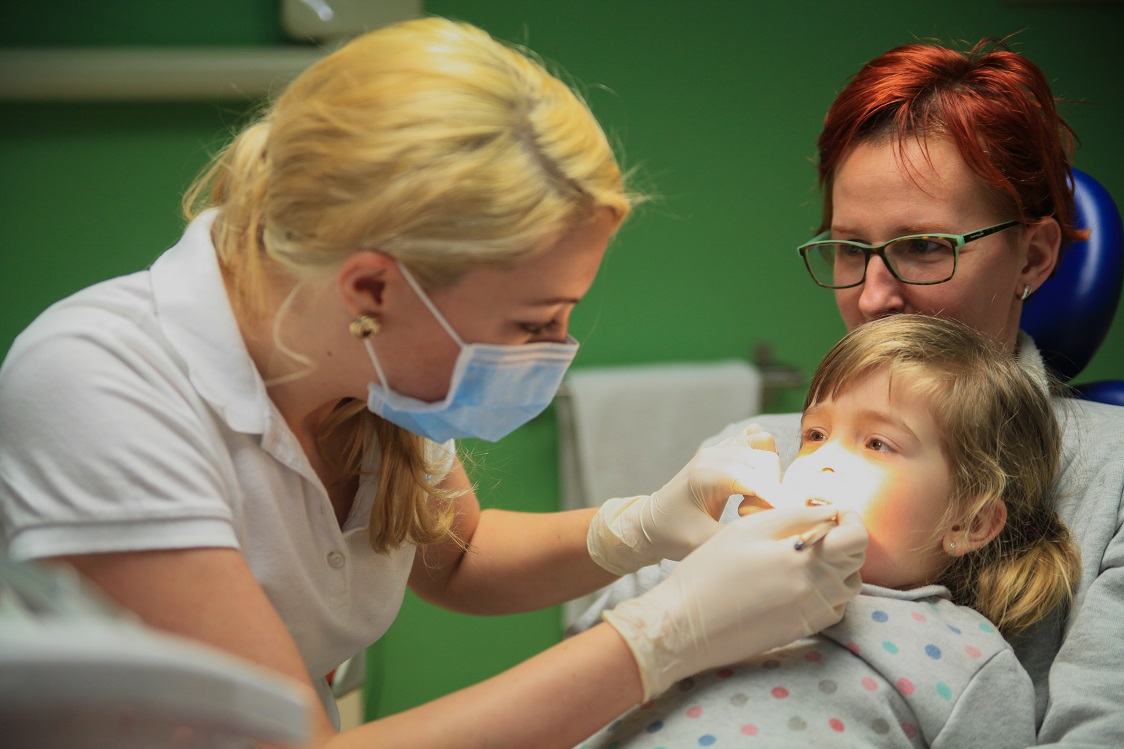Paedodontics - Children’s Dentistry
Caring for baby's new teeth, preventing tooth can lead to a lifetime of better oral health. With proper "maintenance" of milk teeth it can be prevented and avoided from the obstruction and deformation of the permanent teeth.
Baby teeth, milk teeth care - Dental hygiene for babys
Early loss of milk tooth might result the obstruction and deformation of the permanent teeth. With proper "maintenance" of milk teeth it can be prevented and avoided. During the treatment of the decayed milk teeth filling or so called polishing is applied. Polishing means that the decayed part of the tooth is "cut" from the teeth (of course with the proper technology) and we prevent further decay.
Not treated decayed milk teeth might cause dental pulp inflammation or bone tissue inflammation. These problems can be quite painful and beyond physically wearing out the children they van be "worn out" mental as well and it can be very difficult to carry out any kind of treatment or examination in the future. We keep emphasizing the importance of prevention.
When baby teeth appear?
6-7 months: four corner-teeth
7-9 months: further four corner-teeth
10-14 months: four bicuspids
15-18 months: four canine teeth
24-36 months: four gum-teeth
First the baby starts chewing and its gum gets swollen, later it becomes naughty then comes a few days when its teeth are penetrating the gum. It lasts for 3-4 days in case of the corner- teeth, but at the back teeth it can take a week till they penetrate the gum.
Changing teeth
The essence of changing teeth is that the 20 milk teeth fall out and 32 permanent teeth come to their places. Milk teeth period is between age 2 and 6, the mixed teeth period is between age 6 and 12.
The first permanent teeth are the so call No.6 teeth, they appear behind the last milk- grinding teeth at the age of 6. It does not replace a milk tooth, there is no falling out milk tooth, but a lot of people considers it to a milk tooth. The next step of visible teeth changing is the change of the corner teeth, than the rest of the teeth is changing in a undefined order: until the age of 8: bottom- upper corner teeth (8 in total), after age of 9: biscupids and dog- teeth (total 8+4), then the second grinder, the so called No.7 teeth (4 pcs) and finally the wisdom teeth (4 pcs). Penetration of wisdom teeth might be influenced by the lack of place; it also might happen that they stay in the bone.
Problems with changing teeth
In a normal case the roots of the milk teeth work off and the teeth fall out. It often happens that the permanent teeth are coming behind the milk corner teeth. After removing the milk teeth, if there is enough space, they will come to their final places. If no permanent teeth appear on the place of the lost milk teeth, it is good to examine the reason. Problem can be there are more teeth or there are not enough teeth seed. These can be examined easily with an X- ray. With regular control (max. half a year) we can keep track of the tooth changing and if it is needed we start the orthodontia. The early recognition and treatment is really important!
Tooth cleaning in childhood
Cleaning of the teeth has to be started at the infants when the teeth are penetrating the gum. Risk of the decay could be decreased by 95 % at the babies if the early infections were avoided. Nature "worked out" milk teeth as there is no enough space in the mouth of a child for the permanent teeth.
Baby tooth care tips:
Let's stand behind the kid when they are washing their teeth.
Only some toothpaste is needed, which will not foam in the mouth of the child.
Pay attention to this as the kids in this age are not able to spit the unnecessary foam.
Child should not swallow the tooth paste. The fluoride of the tooth paste should be in contact with the teeth to strengthen the dental enamel.
Kids are enjoying of they can do different things on their own, but we also have to be there to ensure that everything goes well.
Kids (age 3-6) tooth care tips:
At the age of 3-6 let's stand behind the child.
If he lets it, bend his head back a little bit and ask him to look forward while we are washing his bottom teeth.
Children shall use tooth brushes for kids, but we have to clean their teeth.
He might be happy if he can apply the tooth paste to the brush but we should insist on the small amount of tooth paste, as it might happen that he swallows the unnecessary tooth paste.
Before the age of 6 it is not probable that the child can spit the tooth paste, but we have to encourage him with give a glass of water for rinsing.
 English
English  German
German Hungarian
Hungarian
